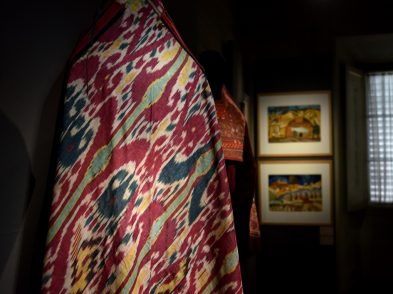Frescoes reached their splendor in the Renaissance and Baroque periods, and Florence abounds with incredibly beautiful frescoes that the decorate walls and ceilings of churches and cloisters, public buildings and private homes. Understand the work that went into creating these paintings and you will find their beauty even more powerful. Understand their fragility and vulnerability, and their mere existence will seem miraculous.
Fresco painting is a very demanding artistic technique―truly an exercise in diligence and skill. A fresco (from the Italian affresco, ‘fresh’) is made up of several layers, each of which must be handled with speed and special care. The process adopted by medieval artists begins with a bare, dampened wall (a buon fresco, ‘wet plaster wall’). It is coated with a layer of coarse lime plaster and sieved river sand or marble dust. Next, the design, or cartoon, is drawn on paper, often in a red earth pigment, sinopia (now the name of both the pigment and the drawing), and placed over the wet plaster. The lines of the drawing are perforated with tiny holes, which are then covered with charcoal; when the paper is removed, the design or cartoon is in the plaster.
Applying pigment pastes (dry powder pigments diluted in water), the artist then paints the composition in sections, tackling only what can be completed during the light of day (giornata, a ‘day’s work’). The pigment, which penetrates the wall in the drying process, quickly becomes permanent, and the colors become vivid. By early dawn on the following day, the wall will be dry: the reaction between the calcium hydrate and the carbonic acid in the atmosphere fix the paint to the wall. No mistakes can be corrected, but embellishments can be added to the dry wall (fresco secco). However, over time, this paint tends to flake off the dry wall.
Cimabue (1240–1304) is considered Florence’s first fresco painter, but Giotto (1267–1337), discovered and trained by Cimabue, overshadowed and excelled his teacher. Cimabue’s early images were in the rigid, Byzantine religious style; later he worked in varied colors and portrayed his images with more of a natural realism, eventually evolving into the Renaissance style. Giotto carried Cimabue’s innovations forward and promoted this relatively ‘new’ art form in artistic circles.
Consequently, Florence is a treasure trove of early frescoes, like those in Chiesa Santa Croce. There, you can see the progression of early fresco style and technique. Start with the Life of St. John, in the Peruzzi Chapel, and the life of St. Francis, in the Bardi Chapel, both attributed to Giotto and executed in fresco secco. Taddeo Gaddi (1300–1366) was Giotto’s godson and worked with the master for 24 years; see his Coronation of the Virgin, in the Baroncelli Chapel and in the Cappella Maggiore. His son, Agnolo Gaddi (active in Florence 1369–1396) painted the Legend of the Cross.
The frescos of Santa Croce have had a perilous existence. The Bardi and Peruzzi Chapels were painted over in the eighteenth century, rediscovered in the nineteenth century, then subsequently restored. In the 1966 flood, the area worst hit was Santa Croce, where the water level reached over 22 feet. When the water evaporated, it left a residue of salt on the surface of the walls, which they then absorbed. The salt became trapped, bubbles emerged, the paintings whitened, and bits of paint flaked and fell off. The adhesion of the plaster to the wall was another major problem.
Saving a fresco is as difficult as creating one. Frescoes can be detached only when they are fully dry. After the flood, in Santa Croce and elsewhere, slim tunnels were cut beneath the frescoes and heaters were used to draw the moisture out from below. Once the fresco was dry, it could delicately be removed from the wall. The tar covering many works had to be dissolved by using Japanese tissue paper and a solvent; talcum powder was distributed on the tissue paper to absorb the solvent. This process may sound simple, but it was a very complicated treatment.
(Read Robert Hellenga’s The Sixteen Pleasures, set in Florence right after the flood, and with a ‘mud angel’ as the main character; it contains a wonderful description of the process of taking a fresco off the wall in an effort to save it.)








